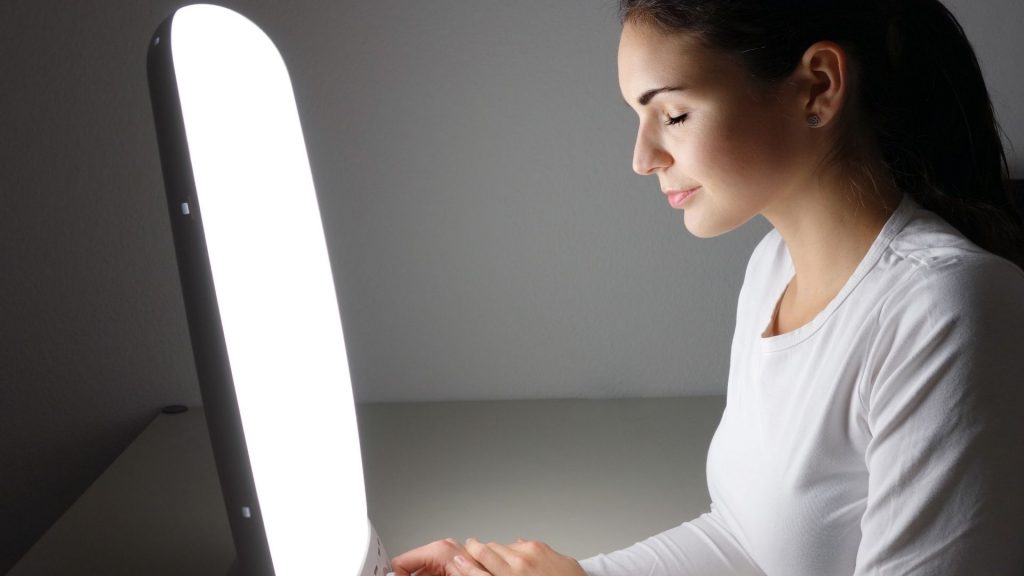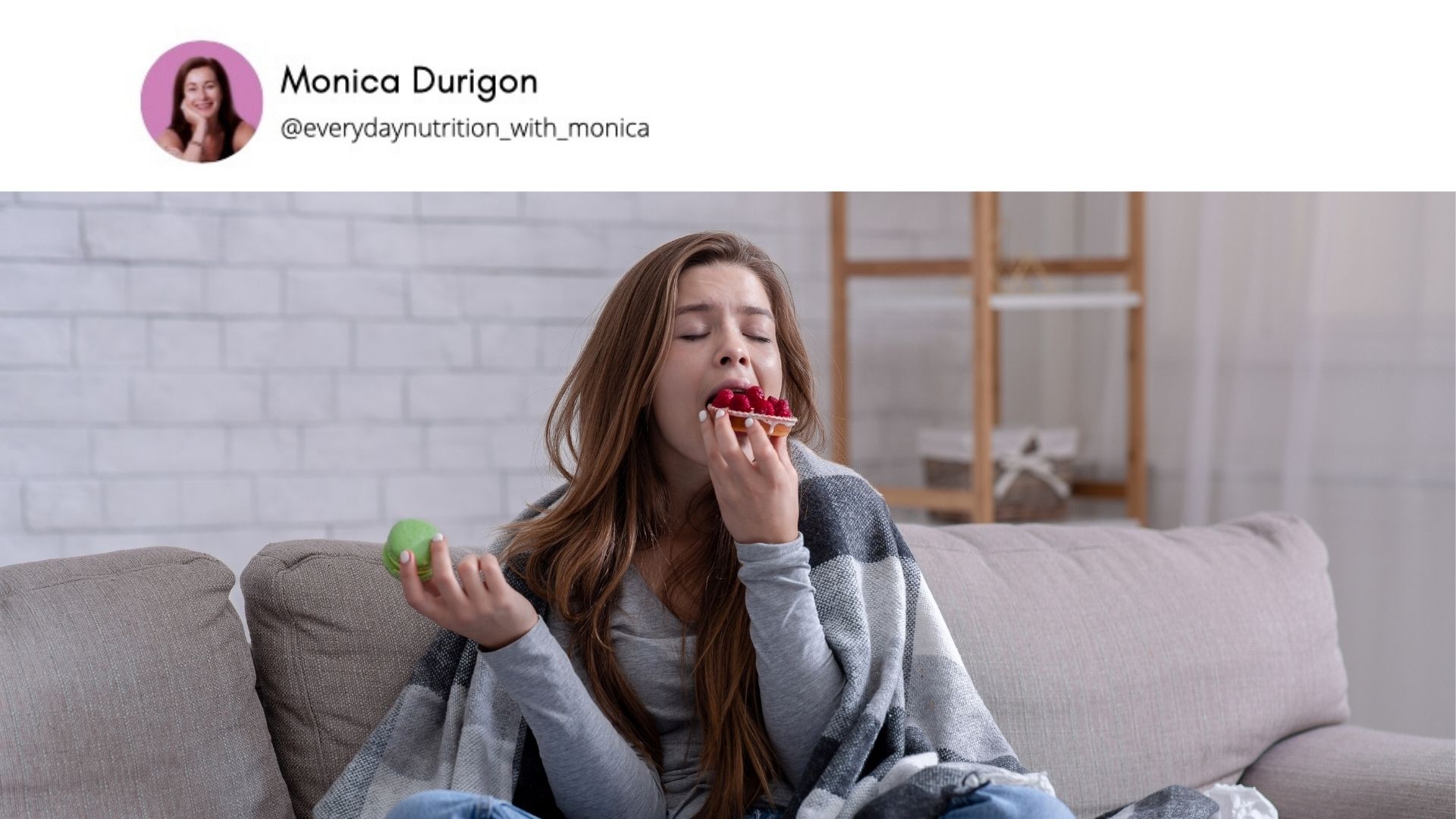As the days grow shorter and the temperatures drop, have you noticed a change in your eating habits? Do you find yourself craving more comfort foods and struggling with mood swings? You’re not alone. Many of my clients tell me they are grappling with increased cravings and a tendency to overeat during the winter months.
This phenomenon is often linked to Seasonal Affective Disorder (SAD), but even if you don’t suffer from SAD, the winter blues can trigger emotional eating. In this blog, I will explore the intriguing connection between SAD and low moods and eating habits and provide practical advice to avoid overeating …because we all know that, although initially, it might offer some comfort, eating to raise your moods does not solve the problem, it actually makes it worse!

What is Seasonal Affective Disorder (SAD)?
Seasonal Affective Disorder, commonly known as SAD, is a type of depression that’s related to changes in seasons. For most people affected by SAD, symptoms start in the fall and continue into the winter months, sapping energy and making them feel moody.
Symptoms of SAD
Symptoms of SAD may include feeling depressed most of the day, nearly every day, losing interest in activities you once enjoyed, having low energy, experiencing sleep disturbances, and changes in appetite or weight. Particularly in the winter variant, there’s often a craving for carbohydrates and a tendency to overeat.
Why SAD and Winter Blues? The Science of Light and Mood
The shorter daylight hours in winter can directly impact our mood. One theory is that reduced sunlight can cause a drop in serotonin, a neurotransmitter that affects mood, appetite, and sleep. Less light also means more melatonin, a hormone that regulates sleep and wakefulness, potentially causing lethargy and symptoms of depression.
Hormonal Effects
Interestingly, the change in season can disrupt the balance of the body’s level of melatonin, which plays a role in sleep patterns and mood. Researchers believe that light therapy can reset the melatonin balance and improve symptoms.
Where You Live Matters
SAD and winter blues are more common in regions far from the equator, where there are fewer daylight hours in the winter. So, the northern you live in… is bad news for SAD sufferers …one more reason to move to the beautiful Mediterranean countries!
Attention! Attention! Women are more affected.
Research indicates that women are more likely to be affected by SAD than men, with some studies suggesting that women are up to four times more likely to be diagnosed with SAD. This gender difference in prevalence may be due to hormonal factors that interact with seasonal changes.

The Link Between SAD, Low Moods and Comfort Eating
During the winter months, do you find yourself craving comfort foods more than usual? Do potatoes, pasta, risotto, and pizza find their way into your menu more than they would the summer months? And what about snuggling up on the sofa with a cup of hot chocolate and some biscuits to dip in? Or maybe you cannot wait to get home from work and have a cup of tea with a slice of your favourite cake?
Turning to Food for Emotional Comfort
When the winter blues hit, it’s not uncommon for many of us to seek solace in food. For individuals grappling with Seasonal Affective Disorder (SAD), this tendency can be even more pronounced. Why does this happen? Food, especially certain types, can provide temporary relief from the symptoms of depression. It’s a form of self-soothing that, while effective in the short term, may lead to unhealthy patterns.
Cravings and Their Types
What kinds do you mostly crave in the winter? For me, it is a cup of hot chocolate and a slice of crostata con Nutella. This is something that my mum used to prepare for us all the time when we were little…and not so little. When we are down, we gravitate towards high-carbohydrate and sugary foods. Think pasta, bread, sweets, chocolate, pastries …. These aren’t just random cravings. There’s a reason we lean towards these foods when feeling low. Carbohydrates can increase levels of serotonin, a neurotransmitter that regulates mood, appetite, and sleep. Serotonin is often called the body’s natural ‘feel-good’ chemical. That is why craving a sweet treat or a carb-heavy meal on a particularly dreary day is common and normal.
Mood Boost through Serotonin Release
How exactly do these foods boost mood? When you consume foods high in carbohydrates, your body increases serotonin production, leading to a temporary mood lift. This effect, however, is short-lived and can lead to a cycle of craving and overeating as the initial ‘high’ wears off. It’s like a quick fix – a temporary patch to a persistent problem. After indulging in a big bowl of pasta or a chocolate bar, have you noticed a brief spike in your mood, followed by a return to or worsening of previous feelings of lethargy or sadness?

Psychology of Comfort Eating: Understanding the Emotional Roots
Comfort eating, often referred to as emotional eating, is deeply rooted in psychological responses. It’s a coping mechanism where food serves as a source of solace and temporary escape from negative emotions such as stress, sadness, loneliness, or boredom. The act of eating comfort foods — typically high in sugar, fat, and calories — can evoke feelings of nostalgia, provide a sense of familiarity, and momentarily elevate mood. How often have you reached for a sweet treat after a stressful day, not out of hunger, but seeking emotional relief?
The Cycle of Temporary Relief and Guilt
The comfort eating cycle usually starts with an emotional trigger, leading to cravings for comfort foods. Consuming these foods can lead to a temporary boost in mood due to the release of neurotransmitters like serotonin. However, this uplift is fleeting. Once the initial comfort dissipates, it’s often replaced by feelings of guilt or shame for overeating or choosing unhealthy foods, especially if one is conscious of their diet or health goals. This guilt can then exacerbate negative emotions, potentially leading to further comfort eating, thus creating a vicious cycle. Have you ever experienced a sense of regret after indulging in comfort eating, only to find yourself in the same pattern during the next emotional low?
Breaking the Cycle
Understanding the psychological underpinnings of comfort eating is the first step in breaking this cycle. It involves recognising the emotional triggers and finding healthier ways to cope with them. Rather than turning to food, alternative strategies like engaging in physical activity, practising mindfulness, or seeking social support can be effective. It’s also important to foster a healthy relationship with food, where it’s seen not as a source of emotional comfort but as nourishment for the body. Reflecting on your own experiences, what alternative coping strategies have you found effective in moments of emotional distress?

Alternative Comfort Strategies
Finding Relief Beyond the Plate
It’s essential to develop strategies that offer comfort without relying on food. Engaging in hobbies that absorb your attention can be a great way to distract from emotional eating urges. Whether it’s painting, gardening, or playing a musical instrument, these activities provide a sense of accomplishment and joy.
The Power of Social Connection
Socialising can also play a crucial role. Spending time with friends or family, even if it’s just a phone call or a walk in the park, can provide emotional support and a different perspective, helping to alleviate stress or sadness.
Self-Care Activities
Practising self-care activities like yoga, meditation, or even a relaxing bath can help manage stress levels. These practices not only promote relaxation but also improve mindfulness, making it easier to identify emotional eating triggers and respond to them in healthier ways.
Get a Happy Lamp
SAD lamps, also known as light therapy boxes, are a tool for alleviating symptoms of winter blues and SAD. These lamps emit light that mimics natural outdoor light and casue a chemical change in the brain that lifts mood. They stimulate the production of serotonin) like carbs-rich food can do, and decrease melatonin levels, thereby improving mood and energy.
There are various types of SAD lamps available, differing mainly in their light intensity, measured in lux, with most therapeutic models providing 10,000 lux. It’s crucial to choose a lamp that filters out UV rays to protect your eyes and skin.
To use a SAD lamp effectively, it’s generally recommended to sit about 16 to 24 inches from the lamp, ensuring the light is directed towards your eyes, but without staring directly at it. The typical usage is about 20-30 minutes per day, ideally in the morning, to mimic the natural rise of the sun. Consistency is key, as daily sessions are more beneficial.
Healthy and Comforting Food Alternatives
Instead of indulging in high-calorie comfort foods, consider healthier alternatives that are equally satisfying. For example:
- Opt for dark chocolate instead of milk chocolate for a mood-boosting treat.
- Swap out chips for air-popped popcorn seasoned with a sprinkle of nutritional yeast or herbs.
- Try Greek yoghurt with nut butter instead of ice cream
- Make a smoothie with almond milk, avocado, a generous scoop of protein powder and a touch of cocoa powder for a sweet yet healthy option.
Remember, the goal is to find foods that are comforting but don’t lead to feelings of guilt or overindulgence.
By exploring these alternative strategies, you can find comfort in ways that nurture both your emotional well-being and physical health. Reflect on which of these strategies resonate with you and how you can incorporate them into your routine to combat emotional eating.
What are your go-to activities for lifting your spirits that don’t involve food?
Can you think of a time when a non-food activity significantly boosted your mood during a rough patch?
I hope this blog will help, and if you know someone who would also benefit from it, please share it with friends, colleagues and family members [THANK YOU].
With love, energy and care,

References:
Kräuchi K, Reich S, Wirz-Justice A. Eating style in seasonal affective disorder: who will gain weight in winter? Compr Psychiatry. 1997 Mar-Apr;38(2):80-7. doi: 10.1016/s0010-440x(97)90085-7. PMID: 9056125.
Penders TM, Stanciu CN, Schoemann AM, Ninan PT, Bloch R, Saeed SA. Bright Light Therapy as Augmentation of Pharmacotherapy for Treatment of Depression: A Systematic Review and Meta-Analysis. Prim Care Companion CNS Disord. 2016 Oct 20;18(5). doi: 10.4088/PCC.15r01906. PMID: 27835725.
Pjrek E, Friedrich ME, Cambioli L, Dold M, Jäger F, Komorowski A, Lanzenberger R, Kasper S, Winkler D. The Efficacy of Light Therapy in the Treatment of Seasonal Affective Disorder: A Meta-Analysis of Randomized Controlled Trials. Psychother Psychosom. 2020;89(1):17-24. doi: 10.1159/000502891. Epub 2019 Oct 1. PMID: 31574513.
Pjrek E, Friedrich ME, Cambioli L, Dold M, Jäger F, Komorowski A, Lanzenberger R, Kasper S, Winkler D. The Efficacy of Light Therapy in the Treatment of Seasonal Affective Disorder: A Meta-Analysis of Randomized Controlled Trials. Psychother Psychosom. 2020;89(1):17-24. doi: 10.1159/000502891. Epub 2019 Oct 1. PMID: 31574513.
Van Strien T, Gibson EL, Baños R, Cebolla A, Winkens LHH. Is comfort food actually comforting for emotional eaters? A (moderated) mediation analysis. Physiol Behav. 2019 Nov 1;211:112671. doi: 10.1016/j.physbeh.2019.112671. Epub 2019 Sep 1. PMID: 31484047.
Yang Yongde, Zhang Sheng, Zhang Xianping, Xu Yongjun, Cheng Junrui, Yang Xue. The Role of Diet, Eating Behavior, and Nutrition Intervention in Seasonal Affective Disorder: A Systematic Review.Frontiers in Psychology, 1, 2020. https://www.frontiersin.org/articles/10.3389/fpsyg.2020.01451





0 Comments